
How to Spend a Literary Long Weekend in Philadelphia
From Poe to Whitman to the Biggest Bloomsday Celebration in the Country
It shouldn’t be surprising that the birthplace of the United States would have strong literary roots; the City of Brotherhood is not only a haven of historical landmarks but continues to inspire a new generation of talent, from a wide-range of independent bookstores, a great public library system, and a strong network of book publishers, literary magazines, and nonprofit educational institutions, including Mighty Writers, Quirk Books, Running Press, PS Books, Matter Press, and Painted Bride Quarterly. While a weekend may be difficult to take everything in both old and new in the city, there’s more than enough to take in on a city meant for walking—thanks to a compact city center and plenty of bike lanes if you choose to use the city’s bike-share program. As W.C. Fields once said, “I once spent a year in Philadelphia, I think it was on a Sunday.”
*
· FRIDAY ·
Logan Square
2:00 pm
No better place to start a book-focused weekend than at the Parkway Central Library. Better known as the Free Library or Central Library to locals, this is the main building of the Free Library of Philadelphia system, with over 50 branches throughout the region. Within its walls, you’ll find a first edition of Alice’s Adventures in Wonderland, early works of Charles Dickens (and even his stuffed raven, Grip!), and drawings by Beatrix Potter. The Library also features some incredible special collections, including one of the largest collections of children’s literature in the country, the world’s largest collection of orchestral music, and over 130,000 maps from around the world, most of which can now be viewed online. The Library is also at the heart of the city, right near the Philadelphia Museum of Art and the Academy of Natural Sciences, and a stunning example of Beaux-Arts architecture. Also, they have a great sister secondhand bookstore around the corner (hence the Book Corner name) that offers books, records, and more, and every purchase helps the public library system. You can easily walk away with a gem for $2.
*
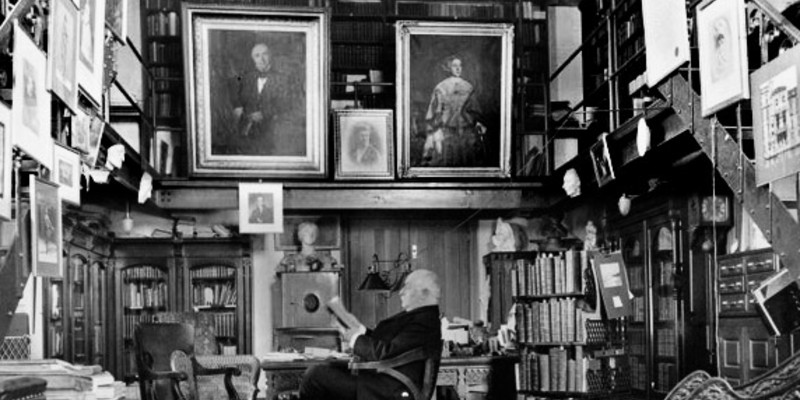
University City / West Philly
4:00pm
Philadelphia is a great college town, and the University of Pennsylvania campus is a great place to start. On the top floor of Penn’s Van Pelt-Dietrich Library is the Kislak Center for Special Collections, Rare Books and Manuscripts, with an impressive collection of manuscripts worth exploring, from works by Jonathan Swift and Shakespeare to a wide range of books printed before 1500 and pamphlets from the French Revolution. What’s surprising about the collection is not just how extensive it is but that it’s easily accessible, as members of the public just need to present an ID at the library entrance to use the collection.
While the beloved Penn Book Center closed for good, wedged between a row of Penn fraternity houses you will find a beautiful Victorian overflowing with books—from floor to ceiling and lining every staircase and hallway. House of Our Own Books has endless nooks to explore, and the history behind the store is just as incredible. During the Vietnam War, the campus was full of political demonstrations, with few places to escape the political debates. The store opened in 1971 focused on history books to provide students and residents context behind the war, a space for anyone who needs to step away from the present moment, hence the “Our” in the store’s name. Another great local bookstore is Hakim’s, which is considered the city’s first African American bookstore and specializes in African American history as well as great selections of children’s literature and memoirs and biographies. Nearby, Penn’s writing center, Kelly Writers House, is open to the public and hosts a number of literary-themed exhibits, book clubs, and readings. You can also find video and audio recordings of its events online.
In case you need any technological trivia, the first computer was created at the University of Pennsylvania’s School of Electrical Engineering. And if you’re looking for a quick bite in the area, indulge in the fried chicken and doughnuts at Federal Donuts from chef Michael Solomonov, winner of the James Beard Foundation Cookbook of the Year in 2016—as well as visit all his great restaurants pocketed throughout the city.
*
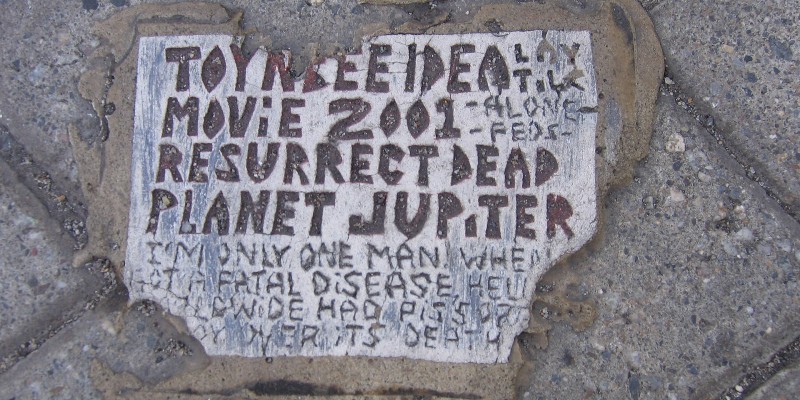
8:00pm
Philadelphia is a great culinary and drinking city, and with that the home of many great arts venues. With the close proximity to New York, the city features many similar talents coming through the city, with an underdog attitude and a more DIY spirit than many of New York’s programming (some of which we highlighted in a night we spent in West Philly). Underground Arts is a cavernous venue that provides a home for local bands and literary readings, art exhibitions, and many performance arts showcases, including the launch of local publication Apiary Magazine, full of live music, DJs, poets reading, and a great dance party. (Close to Apiary Magazine’s Germantown office, at 5427 Germantown Avenue, you can find the approximate location of the now-gone Pine Place where Louisa May Alcott lived the first two years of her life.)
If you’re looking for a fun mystery to explore on a nightly stroll, you should search for three titles on the Avenue of the Arts section of Broad Street with mysterious messages on them. In the 1980s, messages of unknown origins were found embedded in the streets of Philadelphia, roughly the size of an American license plate and made from a mix of linoleum and an asphalt compound. Now spreading as far as Oregon, what’s now known as Toynbee Tiles has never been successfully attributed to an artist, but the documentary Resurrect Dead: The Mystery of the Toynbee Titles claims them to be the work of reclusive Philadelphia resident Severino Verna, and stems from a passage in Arnold Toynbee’s book Experiences. However, other interpretations of the Toynbee reference come from Ray Bradbury, Arthur C. Clarke, and David Mamet—the latter’s claim is from the playwright himself.
*
· SATURDAY ·
West Kensington
9:00 am
Start the day by grabbing a coffee at Amalgam Comics & Coffeehouse, the first black female-owned comic shop on the East Coast, and the city’s top choice to get your fill of comic books and graphic novels. Just a few minutes northeast of Independence Hall and the Liberty Bell, Amalgam has been at the heart of the cultural diversity that’s spread throughout the city. The founder of Amalgam, Ariell R. Johnson, was a graduate of nearby Temple University, and drives the diverse voices featured in the store’s offerings, with a large focus on works by women, people of color, and the LGBTQ community.
And since you’re in the area, you can’t help but visit the humble home of the city’s favorite heavyweight champion, Rocky Balboa, at 1818 E. Tusculum Street.
*

Rittenhouse Square
12:00 pm
Rittenhouse Square Park is one of the best parks to write, and one of five original parks planned by William Penn himself. After taking a nice break at one of its many park benches, find out why yearly Bloomsday celebrations in the city are taken very seriously at the Rosenbach Museum & Library, where you can find the handwritten manuscript of James Joyce’s Ulysses. The museum and library, built from the personal collection of famous art and rare book dealers the Rosenbach brothers, includes a wide range of literary treasures, such as poet Marianne Moore’s complete Greenwich Village living room, first editions of Don Quixote, drawings by Maurice Sendak, and notes and outlines of Bram Stoker’s Dracula.
Also not far is the Mutter Museum, and while not specifically literary, the oddities here cannot be missed, including a slice from Albert Einsten’s brain. (The story goes that despite the physicist’s request for his body not to be studied after his death, the pathologist on duty took Einstein’s brains and eyes to the University of Pennsylvania and dissected and preserved the specimen.)
*
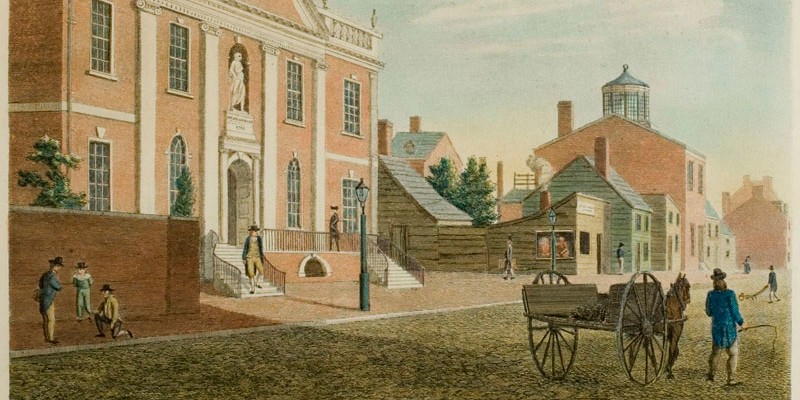
Midtown Village
4:00 pm
Founded by Benjamin Franklin in 1731, The Library Company of Philadelphia was the country’s first public library. At the time, only the wealth and clergy had access to most books, which led Franklin and members from the philosophical association the Junto to combine their resources to start a library. Still free of charge and open to the public, the Library Company houses an extensive collection of rare books, manuscripts, prints, and works of art, including William Penn’s case clock, an electrical machine that Benjamin Franklin used to conduct experiments, and a cuneiform tablet circa 2044 BC.
Nestled between Society Hill and Queen Village is a bibliophile paradise: Head House Books. Along with its frequent author events and ongoing writer workshops, it’s the cozy bookstore you want in any neighborhood, with large carpets and strings of lights hanging from the bookshelves. Try not to lose the whole afternoon here.
*
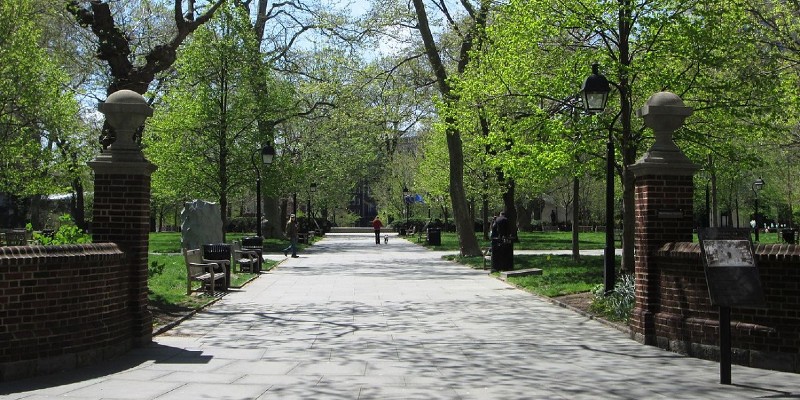
Washington Square
7:00 pm
Afterwards, stroll east to Christ Church Burial Ground to find the burial place of Benjamin Franklin (what’s a literary tour without?). As Carl Van Doren wrote in his biography of Franklin, “No other town burying its great man, ever buried more of itself than Philadelphia with Franklin.” The grave is visible through an iron gate at the corner of 5th and Arch Streets; have a penny handy, as location traditions claims the act of penny tossing will bring you good luck.
Not too far is Washington Square. At the northwest corner of 6th and Walnut Streets, you’ll find the office building of what was once The Curtis Publishing Company, home of the Saturday Evening Post and publications like Holiday, The Country Gentleman, and Ladies’ Home Journal. Inside the lobby what is now the Curtis Center, you’ll find the mosaic Dream Garden lining the wall, designed by Maxfield Parrish and made by Tiffany Studios of 100,000 pieces of Favrile glass. The history of Washington Square is worth exploring on its own, as underneath your feet are the graves of Revolutionary War soldiers and victims of the 1793 yellow fever epidemic. Local resident and author Charles Godfrey Leland had written in his Memoirs of the “confused forms seen flitting over it in the night,” so keep a look out. Not too far north of Washington Square at 901 Clinton Street was once the home of the criminally forgotten essayist Agnes Repplier, who lived almost her entire life in the city. Described by Edward Wagenknecht as “our dean of essayists,” she contributed to Scribner’s and Atlantic Monthly.
*
· SUNDAY ·

Edgar Allan Poe National Historic Site
9:00 am
Sunday is the perfect day to honor two local authors. Start the day honoring one of the country’s greatest writers (and let Philly and Baltimore to argue on who has rights). Nestled in the northern part of the city, at the corner of Seventh and Spring Garden Streets, is the small house that Edgar Allan Poe spent the last year in Philadelphia, writing many of his classic stories, including “The Black Cat,” “The Tell-Tale Heart,” “The Fall of the House of Usher,” and “The Gold Bug.” (The income from the last story is what allowed Poe to rent this brick house.) The historic site is packed with treasures from Poe’s life and fits the setting of a story from the author itself, with the Park Service choosing not to refurnish the space with period furniture but instead allow the rooms to be empty, complete with creaking floors and walls of peeling paint. If you’re lucky, the guide will take you to the basement and recite Poe’s “The Black Cat.” (Editorial note: The Edgar Allan Poe National Historic Site is temporarily closed and rescheduled to open on April 15, 2022.)
*
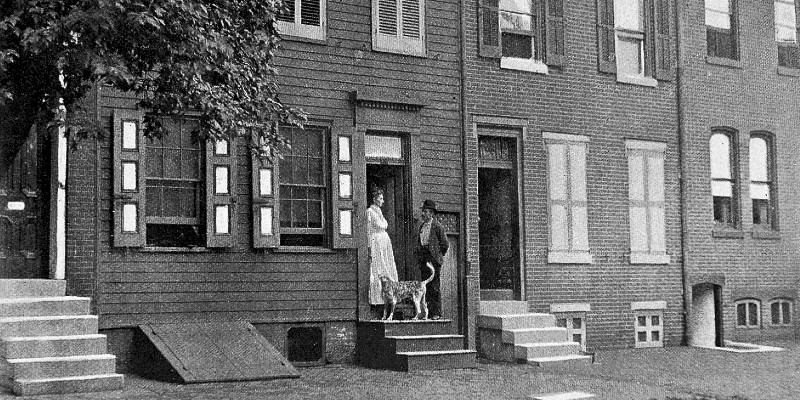
Walt Whitman House
12:00 pm
Just a hop over the Delaware River to Camden is the Walt Whitman House, which was the last residence of the storied poet. After his death, the majority of the contents still remained in the home, and his heirs sold it to the city in 1921; the home was opened to the public five years later. Within the six-room museum, you can see the death bed of the poet and the death notice that was taped to the front door, along with a wide-ranging collection of letters, personal belongings, and photographs—including the earliest known image of Whitman taken on a 1848 daguerreotype.
*
If you’re able to stay in Philly during the week or explore the neighboring cities, there’s a wealth of other amazing spots to explore, from the Pearl S. Buck House at Green Hills Farm in Bucks County that honors the first woman to receive both the Nobel and Pulitzer Prizes to the Narberth Dickens Festival hosted every December in the suburban Philadelphia neighborhood and the James A. Michener Museum in Doylestown. One last must-visit in the city, if you’re there from Monday through Thursday, is to spend an afternoon at the Athenaeum of Philadelphia, one of Philly’s many gems in this city that not enough people know about: located in the Society Hill neighborhood, the Athenaeum’s special library collections focuses on the history of American architecture and building technology, and houses architectural archives of 180,000 drawings, over 350,000 photographs, and manuscript holdings of about 1,000 American architects.



















